Partnership in Health and Social Care: Analysis and Evaluation
VerifiedAdded on 2020/01/07
|17
|4710
|154
Report
AI Summary
This report examines the critical aspects of partnership working within the health and social care sector. It begins by explaining the philosophies underlying successful partnerships, particularly in addressing failures within residential settings. The report then evaluates partnership relations, highlighting both the advantages, such as improved efficiency and cost distribution, and the disadvantages, including communication breakdowns and conflicts. It analyzes various models of partnership working, such as unified, coordinated, coalition, and hybrid models, and reviews relevant legislation and organizational practices. The analysis extends to how differing working practices and policies affect collaboration, incorporating personal and professional development insights. Furthermore, the report evaluates the potential outcomes of partnership working for service users, professionals, and organizations, identifies barriers to successful collaboration, and proposes strategies for improved outcomes. The case study of a London nursing home is used to illustrate the challenges and potential solutions within partnership working.
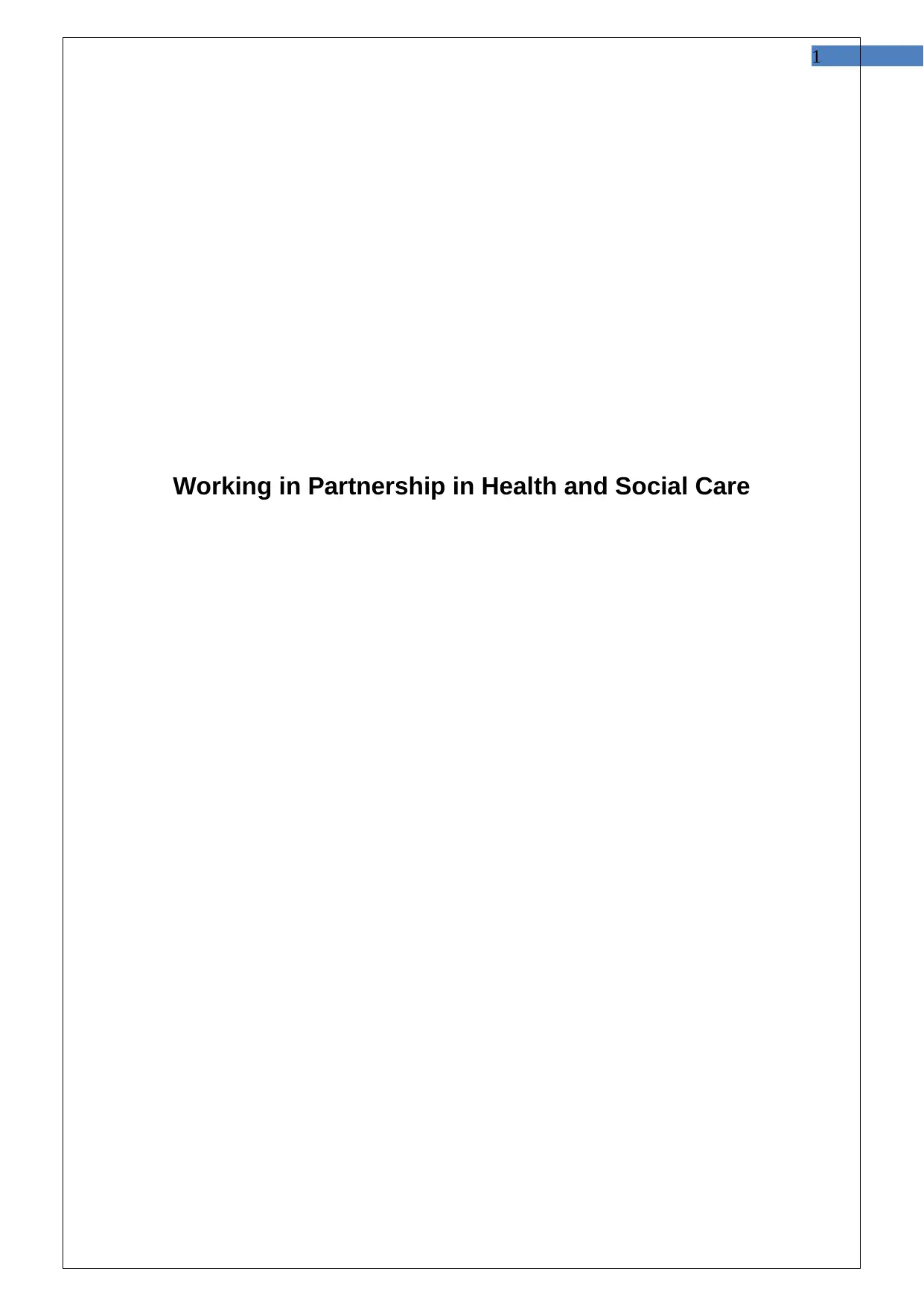
1
Working in Partnership in Health and Social Care
Working in Partnership in Health and Social Care
Paraphrase This Document
Need a fresh take? Get an instant paraphrase of this document with our AI Paraphraser
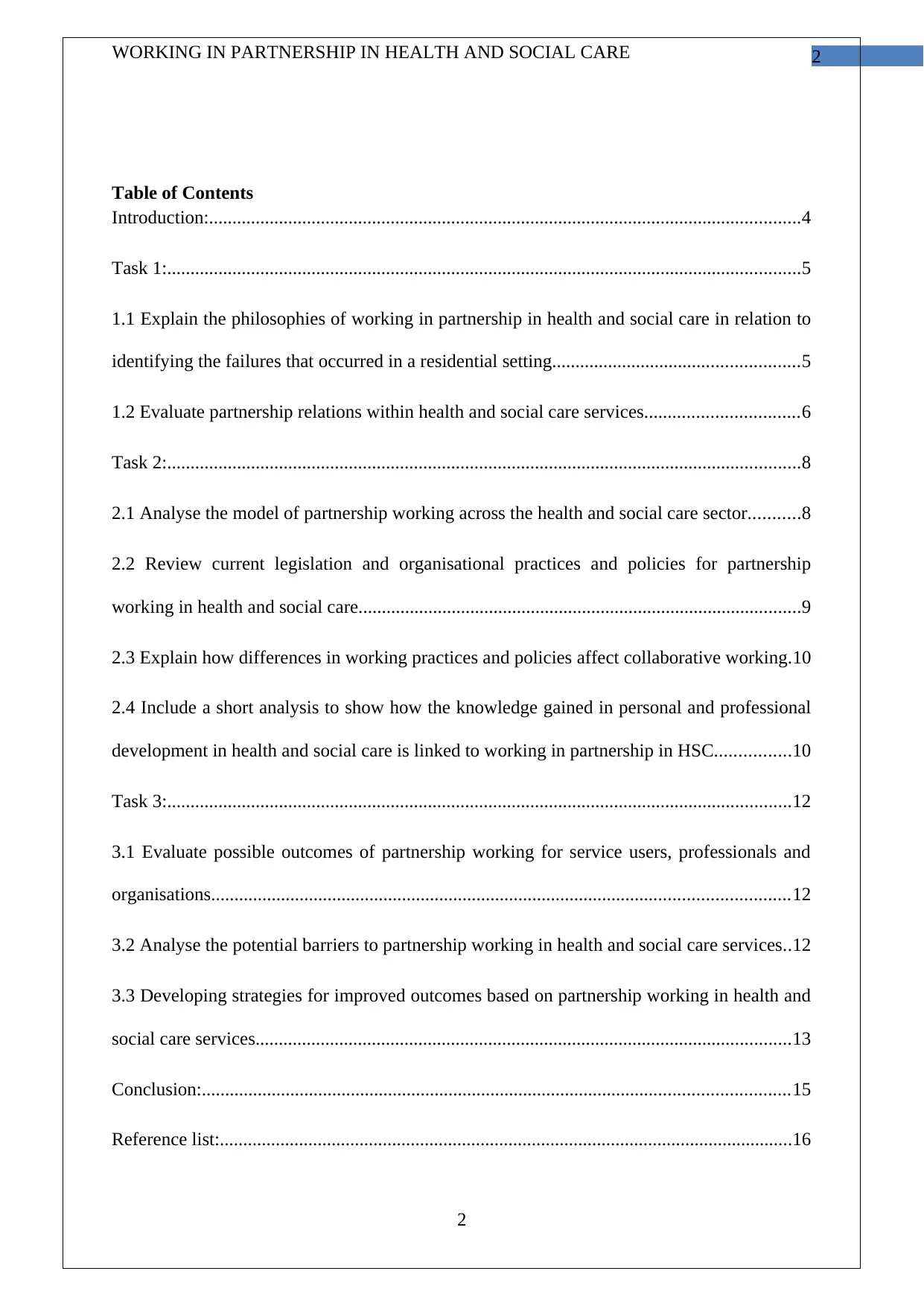
2WORKING IN PARTNERSHIP IN HEALTH AND SOCIAL CARE
Table of Contents
Introduction:...............................................................................................................................4
Task 1:........................................................................................................................................5
1.1 Explain the philosophies of working in partnership in health and social care in relation to
identifying the failures that occurred in a residential setting.....................................................5
1.2 Evaluate partnership relations within health and social care services.................................6
Task 2:........................................................................................................................................8
2.1 Analyse the model of partnership working across the health and social care sector...........8
2.2 Review current legislation and organisational practices and policies for partnership
working in health and social care...............................................................................................9
2.3 Explain how differences in working practices and policies affect collaborative working.10
2.4 Include a short analysis to show how the knowledge gained in personal and professional
development in health and social care is linked to working in partnership in HSC................10
Task 3:......................................................................................................................................12
3.1 Evaluate possible outcomes of partnership working for service users, professionals and
organisations............................................................................................................................12
3.2 Analyse the potential barriers to partnership working in health and social care services..12
3.3 Developing strategies for improved outcomes based on partnership working in health and
social care services...................................................................................................................13
Conclusion:..............................................................................................................................15
Reference list:...........................................................................................................................16
2
Table of Contents
Introduction:...............................................................................................................................4
Task 1:........................................................................................................................................5
1.1 Explain the philosophies of working in partnership in health and social care in relation to
identifying the failures that occurred in a residential setting.....................................................5
1.2 Evaluate partnership relations within health and social care services.................................6
Task 2:........................................................................................................................................8
2.1 Analyse the model of partnership working across the health and social care sector...........8
2.2 Review current legislation and organisational practices and policies for partnership
working in health and social care...............................................................................................9
2.3 Explain how differences in working practices and policies affect collaborative working.10
2.4 Include a short analysis to show how the knowledge gained in personal and professional
development in health and social care is linked to working in partnership in HSC................10
Task 3:......................................................................................................................................12
3.1 Evaluate possible outcomes of partnership working for service users, professionals and
organisations............................................................................................................................12
3.2 Analyse the potential barriers to partnership working in health and social care services..12
3.3 Developing strategies for improved outcomes based on partnership working in health and
social care services...................................................................................................................13
Conclusion:..............................................................................................................................15
Reference list:...........................................................................................................................16
2
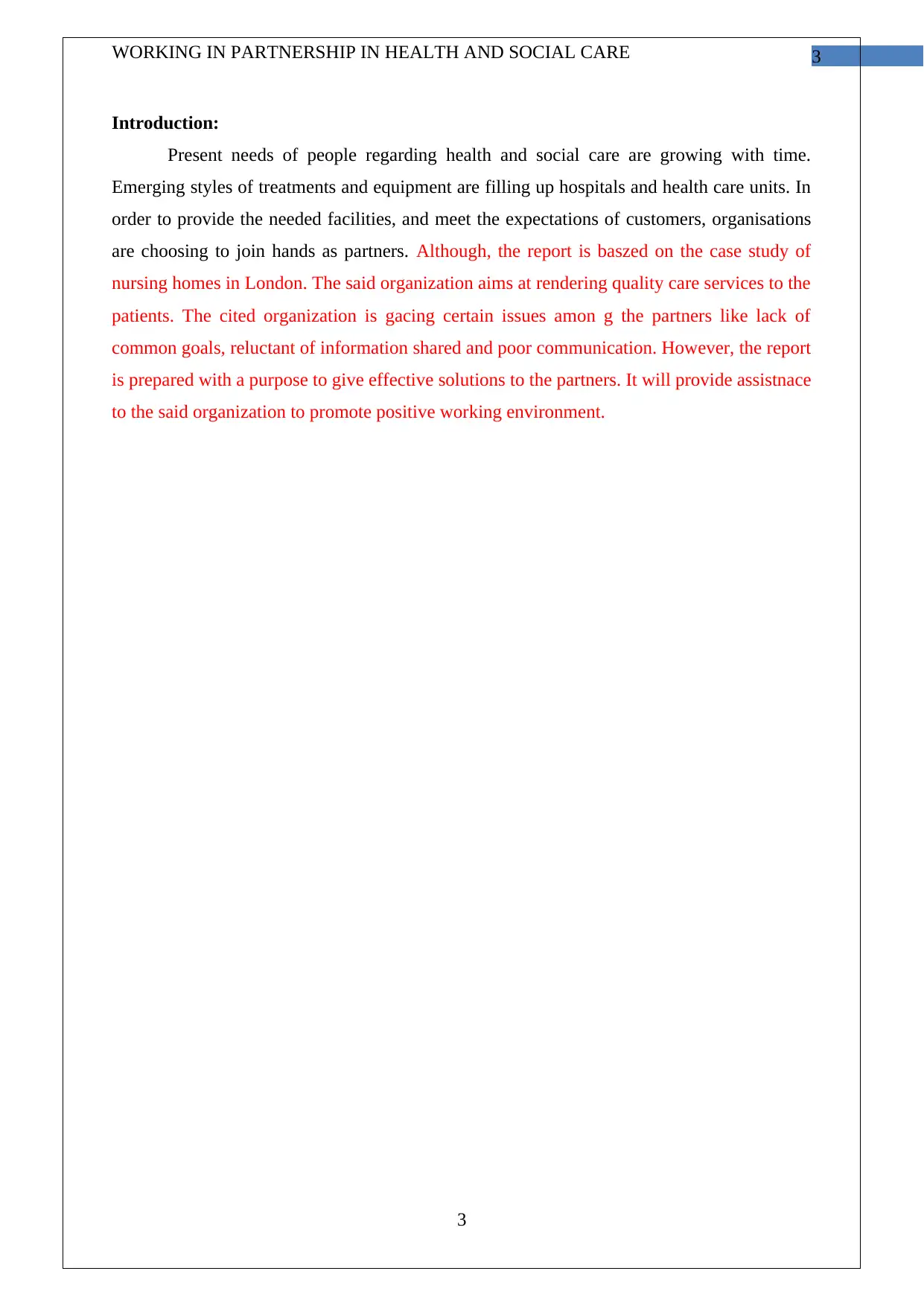
3WORKING IN PARTNERSHIP IN HEALTH AND SOCIAL CARE
Introduction:
Present needs of people regarding health and social care are growing with time.
Emerging styles of treatments and equipment are filling up hospitals and health care units. In
order to provide the needed facilities, and meet the expectations of customers, organisations
are choosing to join hands as partners. Although, the report is baszed on the case study of
nursing homes in London. The said organization aims at rendering quality care services to the
patients. The cited organization is gacing certain issues amon g the partners like lack of
common goals, reluctant of information shared and poor communication. However, the report
is prepared with a purpose to give effective solutions to the partners. It will provide assistnace
to the said organization to promote positive working environment.
3
Introduction:
Present needs of people regarding health and social care are growing with time.
Emerging styles of treatments and equipment are filling up hospitals and health care units. In
order to provide the needed facilities, and meet the expectations of customers, organisations
are choosing to join hands as partners. Although, the report is baszed on the case study of
nursing homes in London. The said organization aims at rendering quality care services to the
patients. The cited organization is gacing certain issues amon g the partners like lack of
common goals, reluctant of information shared and poor communication. However, the report
is prepared with a purpose to give effective solutions to the partners. It will provide assistnace
to the said organization to promote positive working environment.
3
⊘ This is a preview!⊘
Do you want full access?
Subscribe today to unlock all pages.

Trusted by 1+ million students worldwide
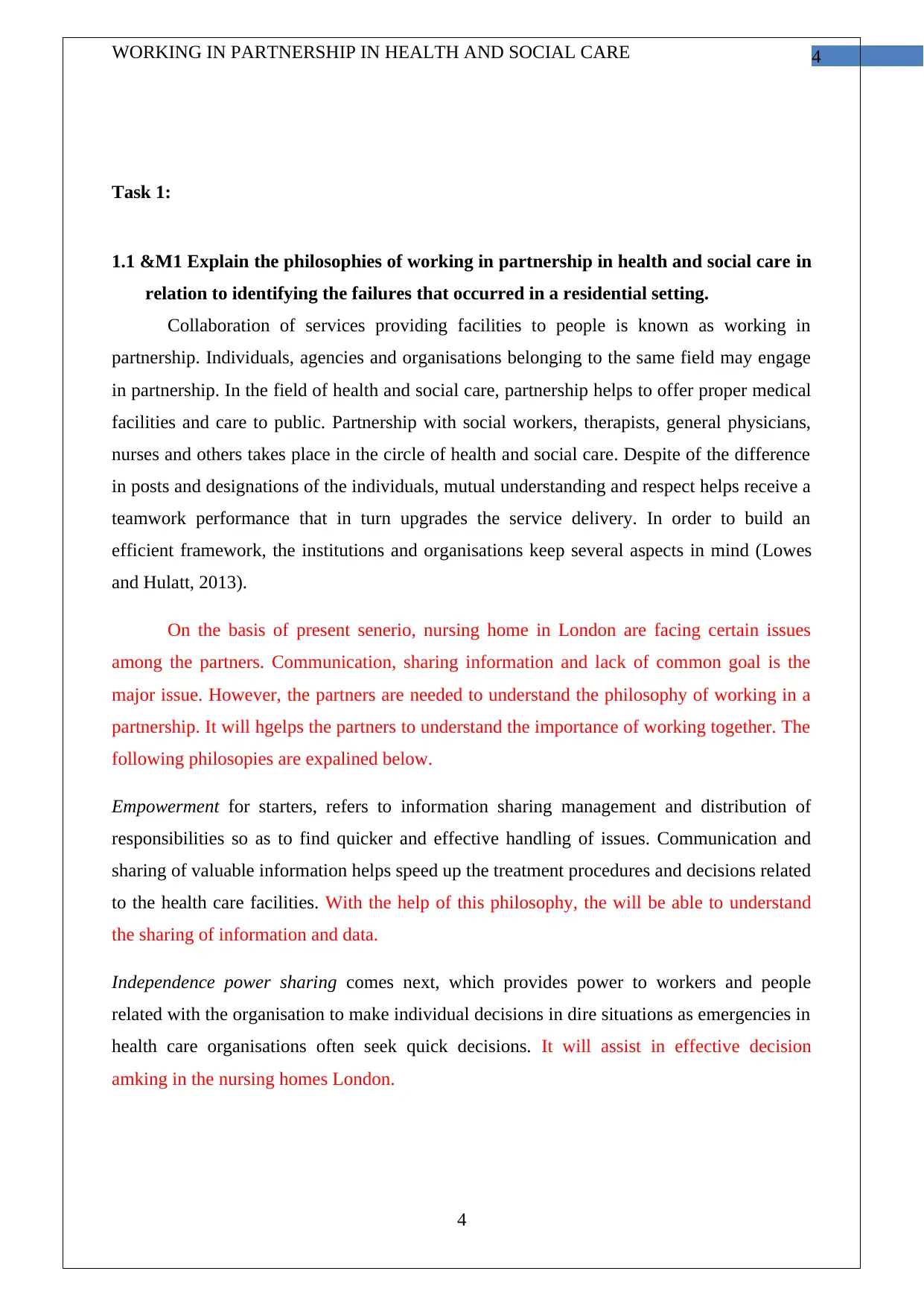
4WORKING IN PARTNERSHIP IN HEALTH AND SOCIAL CARE
Task 1:
1.1 &M1 Explain the philosophies of working in partnership in health and social care in
relation to identifying the failures that occurred in a residential setting.
Collaboration of services providing facilities to people is known as working in
partnership. Individuals, agencies and organisations belonging to the same field may engage
in partnership. In the field of health and social care, partnership helps to offer proper medical
facilities and care to public. Partnership with social workers, therapists, general physicians,
nurses and others takes place in the circle of health and social care. Despite of the difference
in posts and designations of the individuals, mutual understanding and respect helps receive a
teamwork performance that in turn upgrades the service delivery. In order to build an
efficient framework, the institutions and organisations keep several aspects in mind (Lowes
and Hulatt, 2013).
On the basis of present senerio, nursing home in London are facing certain issues
among the partners. Communication, sharing information and lack of common goal is the
major issue. However, the partners are needed to understand the philosophy of working in a
partnership. It will hgelps the partners to understand the importance of working together. The
following philosopies are expalined below.
Empowerment for starters, refers to information sharing management and distribution of
responsibilities so as to find quicker and effective handling of issues. Communication and
sharing of valuable information helps speed up the treatment procedures and decisions related
to the health care facilities. With the help of this philosophy, the will be able to understand
the sharing of information and data.
Independence power sharing comes next, which provides power to workers and people
related with the organisation to make individual decisions in dire situations as emergencies in
health care organisations often seek quick decisions. It will assist in effective decision
amking in the nursing homes London.
4
Task 1:
1.1 &M1 Explain the philosophies of working in partnership in health and social care in
relation to identifying the failures that occurred in a residential setting.
Collaboration of services providing facilities to people is known as working in
partnership. Individuals, agencies and organisations belonging to the same field may engage
in partnership. In the field of health and social care, partnership helps to offer proper medical
facilities and care to public. Partnership with social workers, therapists, general physicians,
nurses and others takes place in the circle of health and social care. Despite of the difference
in posts and designations of the individuals, mutual understanding and respect helps receive a
teamwork performance that in turn upgrades the service delivery. In order to build an
efficient framework, the institutions and organisations keep several aspects in mind (Lowes
and Hulatt, 2013).
On the basis of present senerio, nursing home in London are facing certain issues
among the partners. Communication, sharing information and lack of common goal is the
major issue. However, the partners are needed to understand the philosophy of working in a
partnership. It will hgelps the partners to understand the importance of working together. The
following philosopies are expalined below.
Empowerment for starters, refers to information sharing management and distribution of
responsibilities so as to find quicker and effective handling of issues. Communication and
sharing of valuable information helps speed up the treatment procedures and decisions related
to the health care facilities. With the help of this philosophy, the will be able to understand
the sharing of information and data.
Independence power sharing comes next, which provides power to workers and people
related with the organisation to make individual decisions in dire situations as emergencies in
health care organisations often seek quick decisions. It will assist in effective decision
amking in the nursing homes London.
4
Paraphrase This Document
Need a fresh take? Get an instant paraphrase of this document with our AI Paraphraser
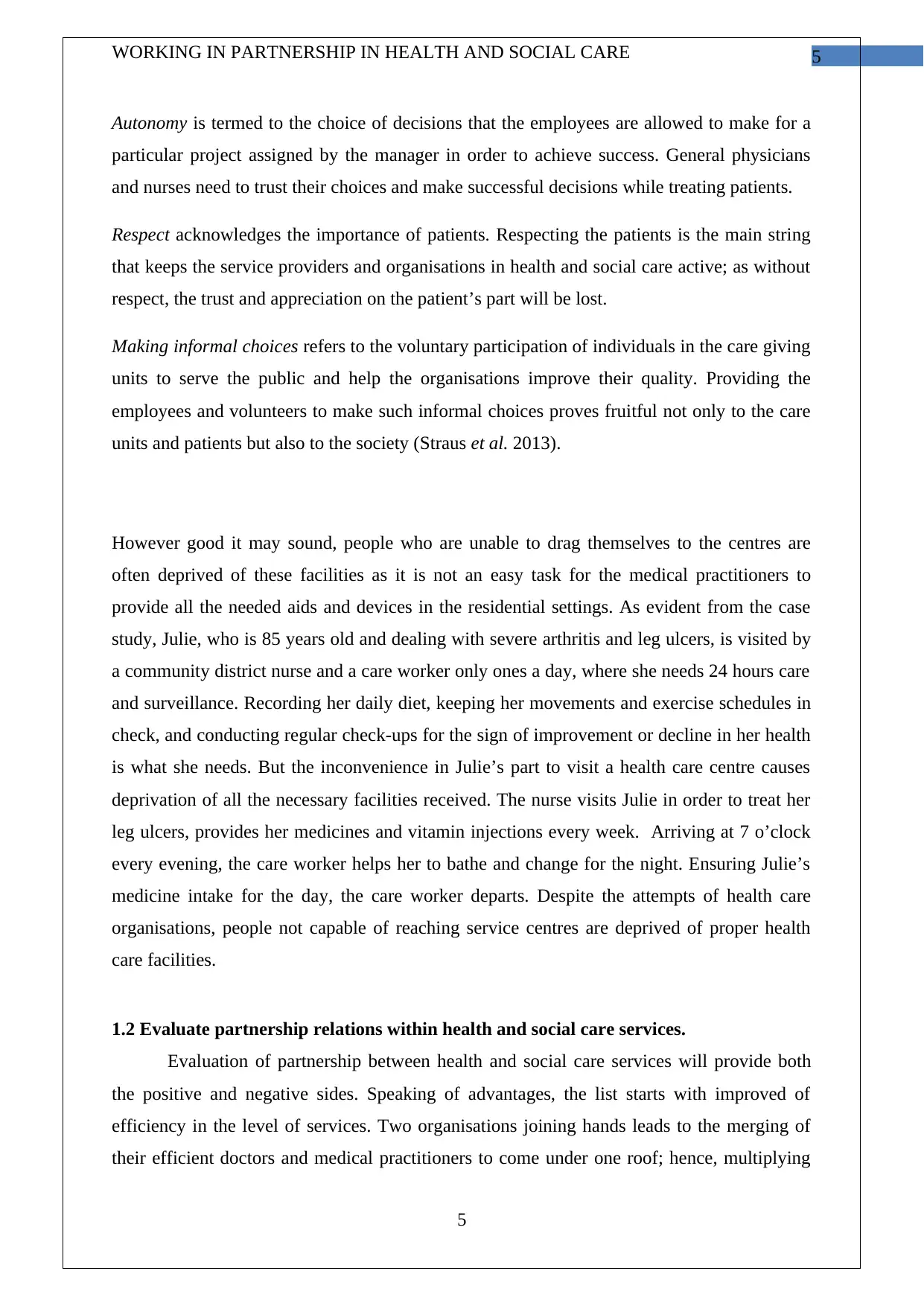
5WORKING IN PARTNERSHIP IN HEALTH AND SOCIAL CARE
Autonomy is termed to the choice of decisions that the employees are allowed to make for a
particular project assigned by the manager in order to achieve success. General physicians
and nurses need to trust their choices and make successful decisions while treating patients.
Respect acknowledges the importance of patients. Respecting the patients is the main string
that keeps the service providers and organisations in health and social care active; as without
respect, the trust and appreciation on the patient’s part will be lost.
Making informal choices refers to the voluntary participation of individuals in the care giving
units to serve the public and help the organisations improve their quality. Providing the
employees and volunteers to make such informal choices proves fruitful not only to the care
units and patients but also to the society (Straus et al. 2013).
However good it may sound, people who are unable to drag themselves to the centres are
often deprived of these facilities as it is not an easy task for the medical practitioners to
provide all the needed aids and devices in the residential settings. As evident from the case
study, Julie, who is 85 years old and dealing with severe arthritis and leg ulcers, is visited by
a community district nurse and a care worker only ones a day, where she needs 24 hours care
and surveillance. Recording her daily diet, keeping her movements and exercise schedules in
check, and conducting regular check-ups for the sign of improvement or decline in her health
is what she needs. But the inconvenience in Julie’s part to visit a health care centre causes
deprivation of all the necessary facilities received. The nurse visits Julie in order to treat her
leg ulcers, provides her medicines and vitamin injections every week. Arriving at 7 o’clock
every evening, the care worker helps her to bathe and change for the night. Ensuring Julie’s
medicine intake for the day, the care worker departs. Despite the attempts of health care
organisations, people not capable of reaching service centres are deprived of proper health
care facilities.
1.2 Evaluate partnership relations within health and social care services.
Evaluation of partnership between health and social care services will provide both
the positive and negative sides. Speaking of advantages, the list starts with improved of
efficiency in the level of services. Two organisations joining hands leads to the merging of
their efficient doctors and medical practitioners to come under one roof; hence, multiplying
5
Autonomy is termed to the choice of decisions that the employees are allowed to make for a
particular project assigned by the manager in order to achieve success. General physicians
and nurses need to trust their choices and make successful decisions while treating patients.
Respect acknowledges the importance of patients. Respecting the patients is the main string
that keeps the service providers and organisations in health and social care active; as without
respect, the trust and appreciation on the patient’s part will be lost.
Making informal choices refers to the voluntary participation of individuals in the care giving
units to serve the public and help the organisations improve their quality. Providing the
employees and volunteers to make such informal choices proves fruitful not only to the care
units and patients but also to the society (Straus et al. 2013).
However good it may sound, people who are unable to drag themselves to the centres are
often deprived of these facilities as it is not an easy task for the medical practitioners to
provide all the needed aids and devices in the residential settings. As evident from the case
study, Julie, who is 85 years old and dealing with severe arthritis and leg ulcers, is visited by
a community district nurse and a care worker only ones a day, where she needs 24 hours care
and surveillance. Recording her daily diet, keeping her movements and exercise schedules in
check, and conducting regular check-ups for the sign of improvement or decline in her health
is what she needs. But the inconvenience in Julie’s part to visit a health care centre causes
deprivation of all the necessary facilities received. The nurse visits Julie in order to treat her
leg ulcers, provides her medicines and vitamin injections every week. Arriving at 7 o’clock
every evening, the care worker helps her to bathe and change for the night. Ensuring Julie’s
medicine intake for the day, the care worker departs. Despite the attempts of health care
organisations, people not capable of reaching service centres are deprived of proper health
care facilities.
1.2 Evaluate partnership relations within health and social care services.
Evaluation of partnership between health and social care services will provide both
the positive and negative sides. Speaking of advantages, the list starts with improved of
efficiency in the level of services. Two organisations joining hands leads to the merging of
their efficient doctors and medical practitioners to come under one roof; hence, multiplying
5
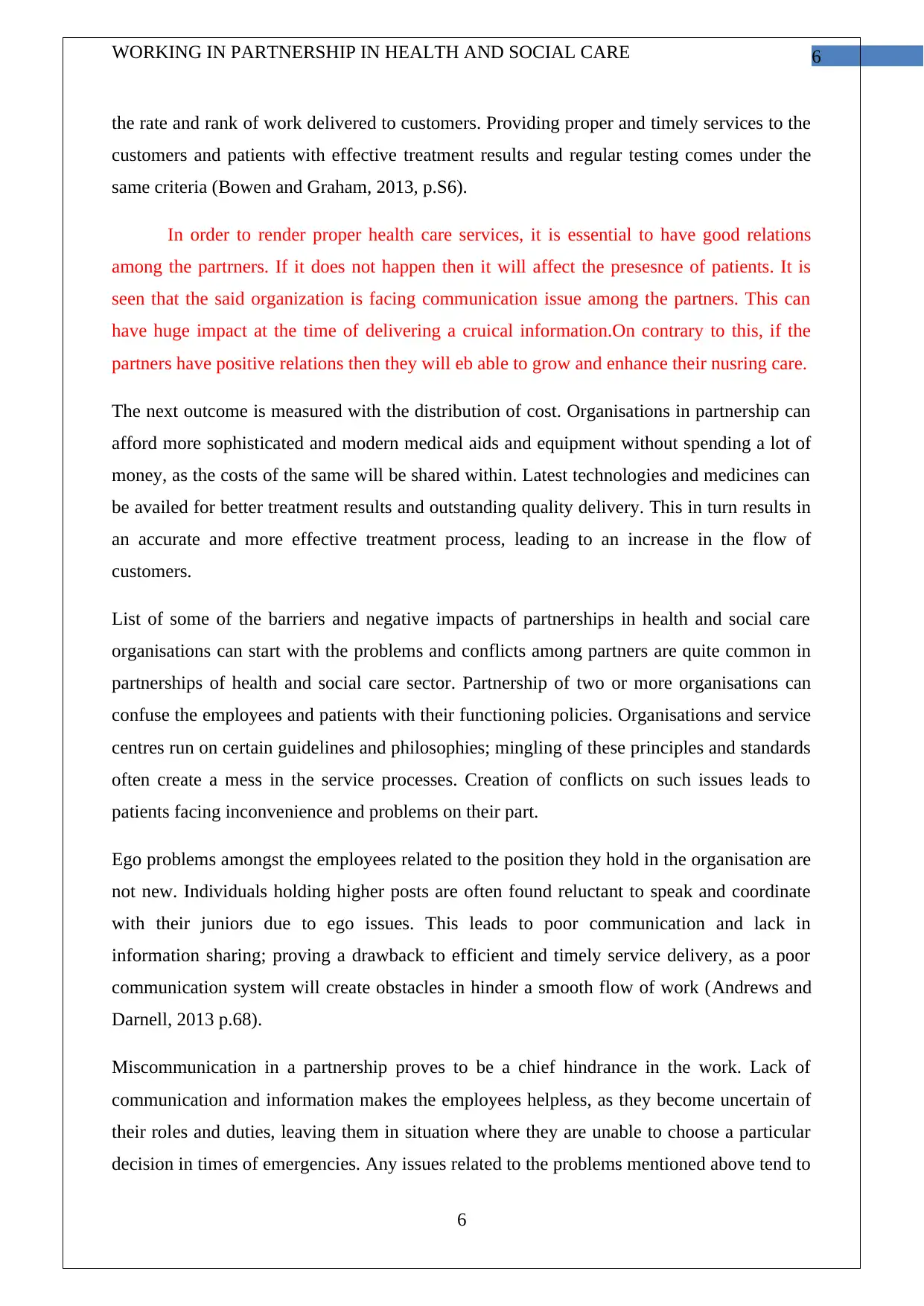
6WORKING IN PARTNERSHIP IN HEALTH AND SOCIAL CARE
the rate and rank of work delivered to customers. Providing proper and timely services to the
customers and patients with effective treatment results and regular testing comes under the
same criteria (Bowen and Graham, 2013, p.S6).
In order to render proper health care services, it is essential to have good relations
among the partrners. If it does not happen then it will affect the presesnce of patients. It is
seen that the said organization is facing communication issue among the partners. This can
have huge impact at the time of delivering a cruical information.On contrary to this, if the
partners have positive relations then they will eb able to grow and enhance their nusring care.
The next outcome is measured with the distribution of cost. Organisations in partnership can
afford more sophisticated and modern medical aids and equipment without spending a lot of
money, as the costs of the same will be shared within. Latest technologies and medicines can
be availed for better treatment results and outstanding quality delivery. This in turn results in
an accurate and more effective treatment process, leading to an increase in the flow of
customers.
List of some of the barriers and negative impacts of partnerships in health and social care
organisations can start with the problems and conflicts among partners are quite common in
partnerships of health and social care sector. Partnership of two or more organisations can
confuse the employees and patients with their functioning policies. Organisations and service
centres run on certain guidelines and philosophies; mingling of these principles and standards
often create a mess in the service processes. Creation of conflicts on such issues leads to
patients facing inconvenience and problems on their part.
Ego problems amongst the employees related to the position they hold in the organisation are
not new. Individuals holding higher posts are often found reluctant to speak and coordinate
with their juniors due to ego issues. This leads to poor communication and lack in
information sharing; proving a drawback to efficient and timely service delivery, as a poor
communication system will create obstacles in hinder a smooth flow of work (Andrews and
Darnell, 2013 p.68).
Miscommunication in a partnership proves to be a chief hindrance in the work. Lack of
communication and information makes the employees helpless, as they become uncertain of
their roles and duties, leaving them in situation where they are unable to choose a particular
decision in times of emergencies. Any issues related to the problems mentioned above tend to
6
the rate and rank of work delivered to customers. Providing proper and timely services to the
customers and patients with effective treatment results and regular testing comes under the
same criteria (Bowen and Graham, 2013, p.S6).
In order to render proper health care services, it is essential to have good relations
among the partrners. If it does not happen then it will affect the presesnce of patients. It is
seen that the said organization is facing communication issue among the partners. This can
have huge impact at the time of delivering a cruical information.On contrary to this, if the
partners have positive relations then they will eb able to grow and enhance their nusring care.
The next outcome is measured with the distribution of cost. Organisations in partnership can
afford more sophisticated and modern medical aids and equipment without spending a lot of
money, as the costs of the same will be shared within. Latest technologies and medicines can
be availed for better treatment results and outstanding quality delivery. This in turn results in
an accurate and more effective treatment process, leading to an increase in the flow of
customers.
List of some of the barriers and negative impacts of partnerships in health and social care
organisations can start with the problems and conflicts among partners are quite common in
partnerships of health and social care sector. Partnership of two or more organisations can
confuse the employees and patients with their functioning policies. Organisations and service
centres run on certain guidelines and philosophies; mingling of these principles and standards
often create a mess in the service processes. Creation of conflicts on such issues leads to
patients facing inconvenience and problems on their part.
Ego problems amongst the employees related to the position they hold in the organisation are
not new. Individuals holding higher posts are often found reluctant to speak and coordinate
with their juniors due to ego issues. This leads to poor communication and lack in
information sharing; proving a drawback to efficient and timely service delivery, as a poor
communication system will create obstacles in hinder a smooth flow of work (Andrews and
Darnell, 2013 p.68).
Miscommunication in a partnership proves to be a chief hindrance in the work. Lack of
communication and information makes the employees helpless, as they become uncertain of
their roles and duties, leaving them in situation where they are unable to choose a particular
decision in times of emergencies. Any issues related to the problems mentioned above tend to
6
⊘ This is a preview!⊘
Do you want full access?
Subscribe today to unlock all pages.

Trusted by 1+ million students worldwide
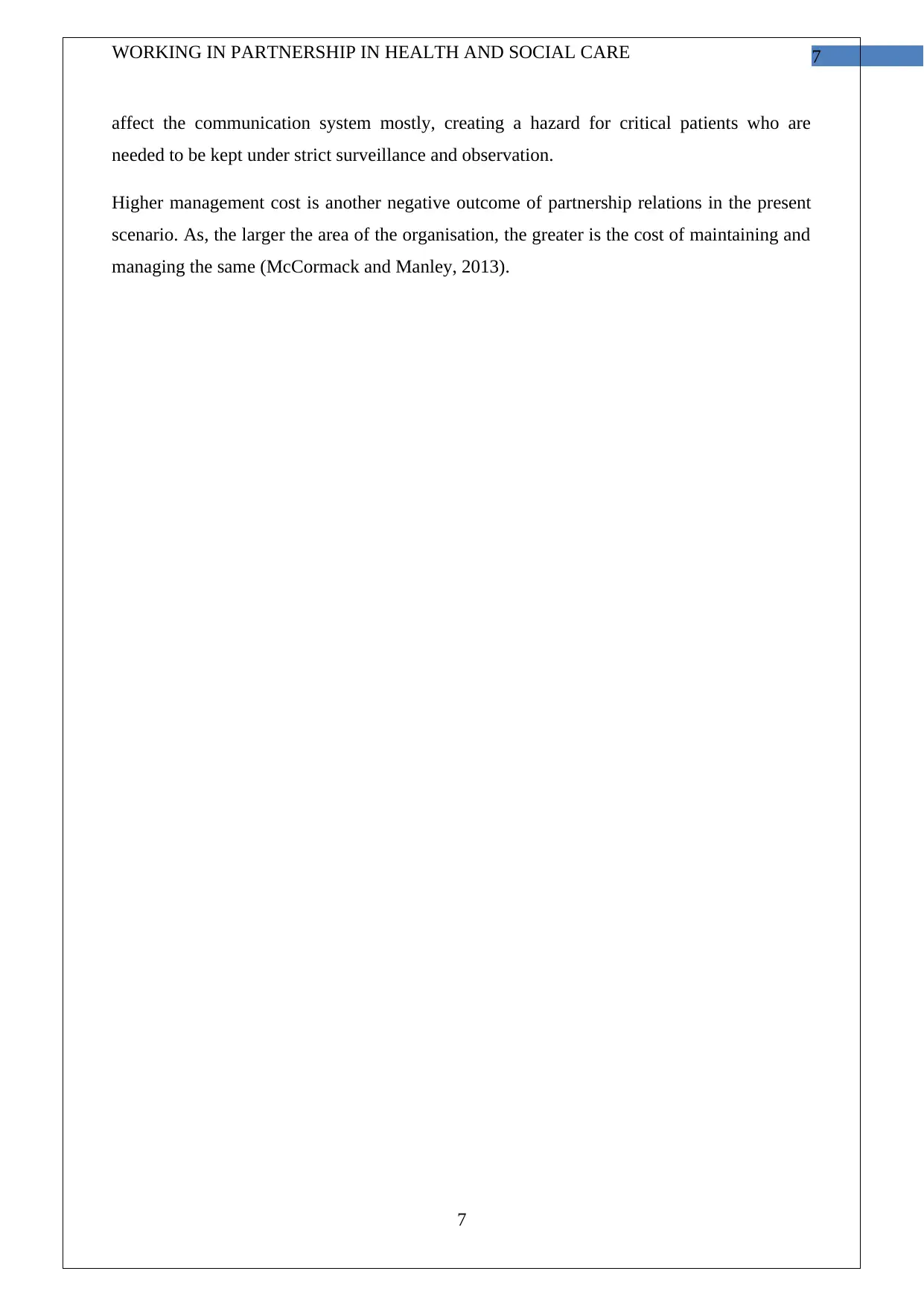
7WORKING IN PARTNERSHIP IN HEALTH AND SOCIAL CARE
affect the communication system mostly, creating a hazard for critical patients who are
needed to be kept under strict surveillance and observation.
Higher management cost is another negative outcome of partnership relations in the present
scenario. As, the larger the area of the organisation, the greater is the cost of maintaining and
managing the same (McCormack and Manley, 2013).
7
affect the communication system mostly, creating a hazard for critical patients who are
needed to be kept under strict surveillance and observation.
Higher management cost is another negative outcome of partnership relations in the present
scenario. As, the larger the area of the organisation, the greater is the cost of maintaining and
managing the same (McCormack and Manley, 2013).
7
Paraphrase This Document
Need a fresh take? Get an instant paraphrase of this document with our AI Paraphraser
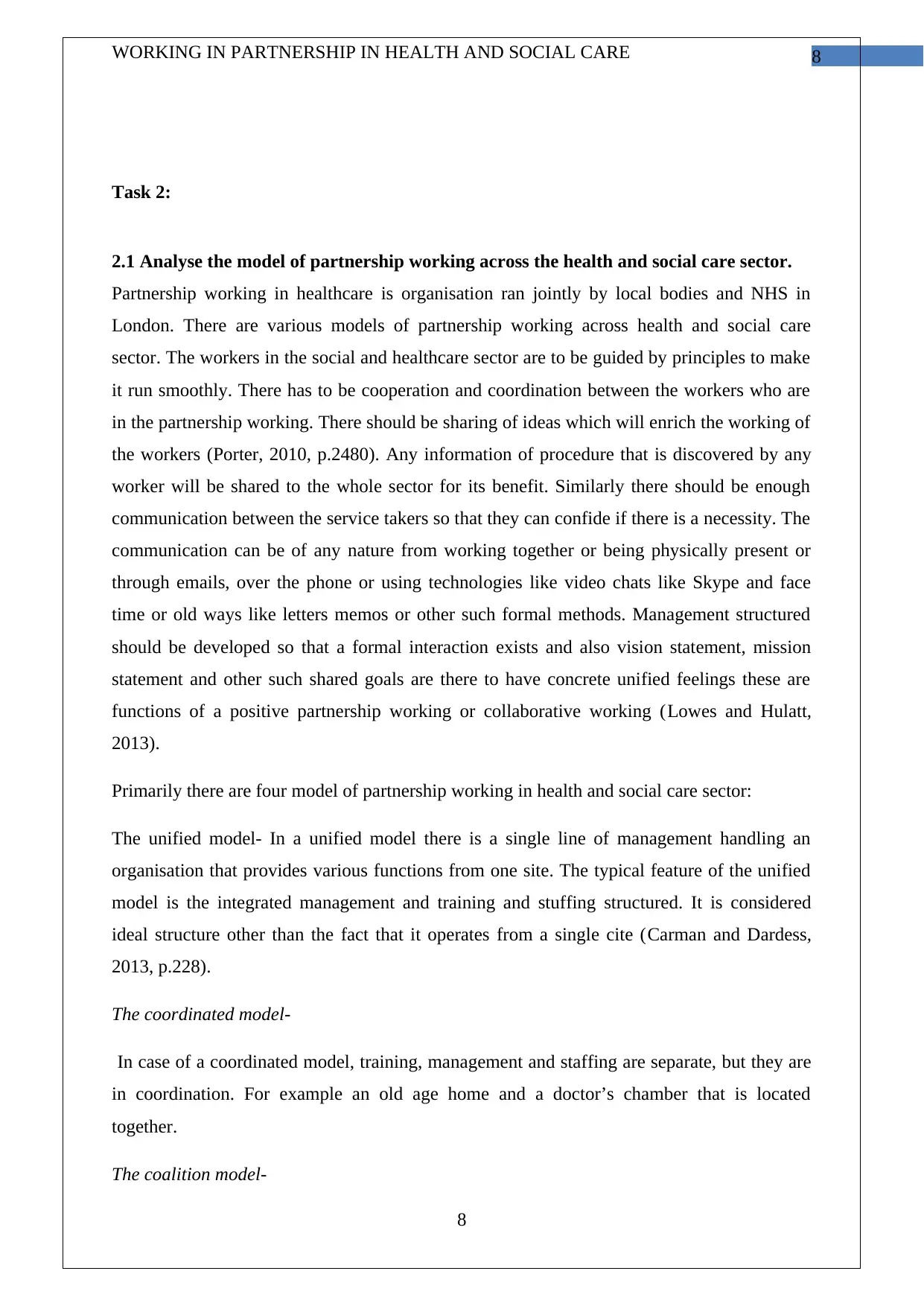
8WORKING IN PARTNERSHIP IN HEALTH AND SOCIAL CARE
Task 2:
2.1 Analyse the model of partnership working across the health and social care sector.
Partnership working in healthcare is organisation ran jointly by local bodies and NHS in
London. There are various models of partnership working across health and social care
sector. The workers in the social and healthcare sector are to be guided by principles to make
it run smoothly. There has to be cooperation and coordination between the workers who are
in the partnership working. There should be sharing of ideas which will enrich the working of
the workers (Porter, 2010, p.2480). Any information of procedure that is discovered by any
worker will be shared to the whole sector for its benefit. Similarly there should be enough
communication between the service takers so that they can confide if there is a necessity. The
communication can be of any nature from working together or being physically present or
through emails, over the phone or using technologies like video chats like Skype and face
time or old ways like letters memos or other such formal methods. Management structured
should be developed so that a formal interaction exists and also vision statement, mission
statement and other such shared goals are there to have concrete unified feelings these are
functions of a positive partnership working or collaborative working (Lowes and Hulatt,
2013).
Primarily there are four model of partnership working in health and social care sector:
The unified model- In a unified model there is a single line of management handling an
organisation that provides various functions from one site. The typical feature of the unified
model is the integrated management and training and stuffing structured. It is considered
ideal structure other than the fact that it operates from a single cite (Carman and Dardess,
2013, p.228).
The coordinated model-
In case of a coordinated model, training, management and staffing are separate, but they are
in coordination. For example an old age home and a doctor’s chamber that is located
together.
The coalition model-
8
Task 2:
2.1 Analyse the model of partnership working across the health and social care sector.
Partnership working in healthcare is organisation ran jointly by local bodies and NHS in
London. There are various models of partnership working across health and social care
sector. The workers in the social and healthcare sector are to be guided by principles to make
it run smoothly. There has to be cooperation and coordination between the workers who are
in the partnership working. There should be sharing of ideas which will enrich the working of
the workers (Porter, 2010, p.2480). Any information of procedure that is discovered by any
worker will be shared to the whole sector for its benefit. Similarly there should be enough
communication between the service takers so that they can confide if there is a necessity. The
communication can be of any nature from working together or being physically present or
through emails, over the phone or using technologies like video chats like Skype and face
time or old ways like letters memos or other such formal methods. Management structured
should be developed so that a formal interaction exists and also vision statement, mission
statement and other such shared goals are there to have concrete unified feelings these are
functions of a positive partnership working or collaborative working (Lowes and Hulatt,
2013).
Primarily there are four model of partnership working in health and social care sector:
The unified model- In a unified model there is a single line of management handling an
organisation that provides various functions from one site. The typical feature of the unified
model is the integrated management and training and stuffing structured. It is considered
ideal structure other than the fact that it operates from a single cite (Carman and Dardess,
2013, p.228).
The coordinated model-
In case of a coordinated model, training, management and staffing are separate, but they are
in coordination. For example an old age home and a doctor’s chamber that is located
together.
The coalition model-
8
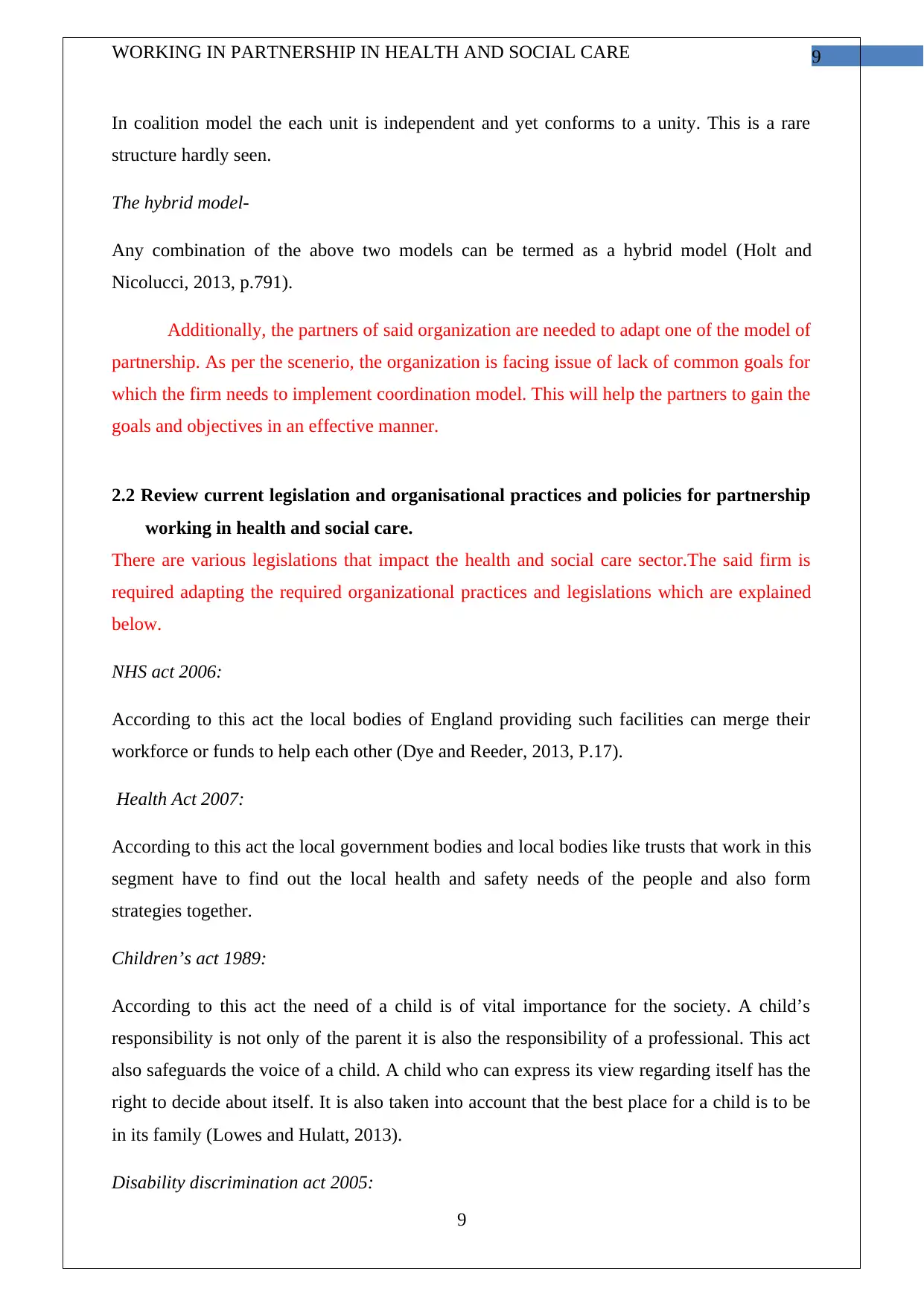
9WORKING IN PARTNERSHIP IN HEALTH AND SOCIAL CARE
In coalition model the each unit is independent and yet conforms to a unity. This is a rare
structure hardly seen.
The hybrid model-
Any combination of the above two models can be termed as a hybrid model (Holt and
Nicolucci, 2013, p.791).
Additionally, the partners of said organization are needed to adapt one of the model of
partnership. As per the scenerio, the organization is facing issue of lack of common goals for
which the firm needs to implement coordination model. This will help the partners to gain the
goals and objectives in an effective manner.
2.2 Review current legislation and organisational practices and policies for partnership
working in health and social care.
There are various legislations that impact the health and social care sector.The said firm is
required adapting the required organizational practices and legislations which are explained
below.
NHS act 2006:
According to this act the local bodies of England providing such facilities can merge their
workforce or funds to help each other (Dye and Reeder, 2013, P.17).
Health Act 2007:
According to this act the local government bodies and local bodies like trusts that work in this
segment have to find out the local health and safety needs of the people and also form
strategies together.
Children’s act 1989:
According to this act the need of a child is of vital importance for the society. A child’s
responsibility is not only of the parent it is also the responsibility of a professional. This act
also safeguards the voice of a child. A child who can express its view regarding itself has the
right to decide about itself. It is also taken into account that the best place for a child is to be
in its family (Lowes and Hulatt, 2013).
Disability discrimination act 2005:
9
In coalition model the each unit is independent and yet conforms to a unity. This is a rare
structure hardly seen.
The hybrid model-
Any combination of the above two models can be termed as a hybrid model (Holt and
Nicolucci, 2013, p.791).
Additionally, the partners of said organization are needed to adapt one of the model of
partnership. As per the scenerio, the organization is facing issue of lack of common goals for
which the firm needs to implement coordination model. This will help the partners to gain the
goals and objectives in an effective manner.
2.2 Review current legislation and organisational practices and policies for partnership
working in health and social care.
There are various legislations that impact the health and social care sector.The said firm is
required adapting the required organizational practices and legislations which are explained
below.
NHS act 2006:
According to this act the local bodies of England providing such facilities can merge their
workforce or funds to help each other (Dye and Reeder, 2013, P.17).
Health Act 2007:
According to this act the local government bodies and local bodies like trusts that work in this
segment have to find out the local health and safety needs of the people and also form
strategies together.
Children’s act 1989:
According to this act the need of a child is of vital importance for the society. A child’s
responsibility is not only of the parent it is also the responsibility of a professional. This act
also safeguards the voice of a child. A child who can express its view regarding itself has the
right to decide about itself. It is also taken into account that the best place for a child is to be
in its family (Lowes and Hulatt, 2013).
Disability discrimination act 2005:
9
⊘ This is a preview!⊘
Do you want full access?
Subscribe today to unlock all pages.

Trusted by 1+ million students worldwide
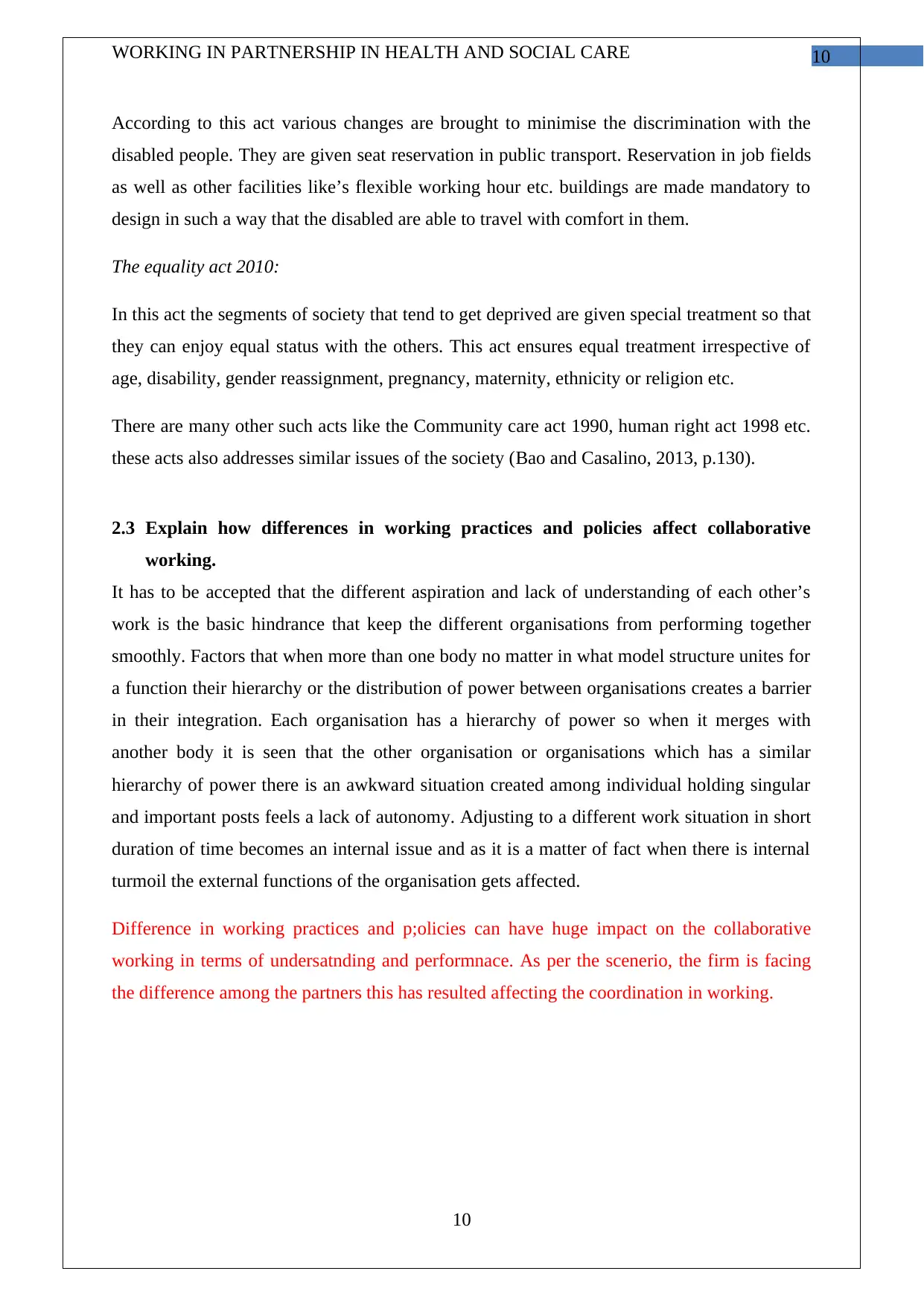
10WORKING IN PARTNERSHIP IN HEALTH AND SOCIAL CARE
According to this act various changes are brought to minimise the discrimination with the
disabled people. They are given seat reservation in public transport. Reservation in job fields
as well as other facilities like’s flexible working hour etc. buildings are made mandatory to
design in such a way that the disabled are able to travel with comfort in them.
The equality act 2010:
In this act the segments of society that tend to get deprived are given special treatment so that
they can enjoy equal status with the others. This act ensures equal treatment irrespective of
age, disability, gender reassignment, pregnancy, maternity, ethnicity or religion etc.
There are many other such acts like the Community care act 1990, human right act 1998 etc.
these acts also addresses similar issues of the society (Bao and Casalino, 2013, p.130).
2.3 Explain how differences in working practices and policies affect collaborative
working.
It has to be accepted that the different aspiration and lack of understanding of each other’s
work is the basic hindrance that keep the different organisations from performing together
smoothly. Factors that when more than one body no matter in what model structure unites for
a function their hierarchy or the distribution of power between organisations creates a barrier
in their integration. Each organisation has a hierarchy of power so when it merges with
another body it is seen that the other organisation or organisations which has a similar
hierarchy of power there is an awkward situation created among individual holding singular
and important posts feels a lack of autonomy. Adjusting to a different work situation in short
duration of time becomes an internal issue and as it is a matter of fact when there is internal
turmoil the external functions of the organisation gets affected.
Difference in working practices and p;olicies can have huge impact on the collaborative
working in terms of undersatnding and performnace. As per the scenerio, the firm is facing
the difference among the partners this has resulted affecting the coordination in working.
10
According to this act various changes are brought to minimise the discrimination with the
disabled people. They are given seat reservation in public transport. Reservation in job fields
as well as other facilities like’s flexible working hour etc. buildings are made mandatory to
design in such a way that the disabled are able to travel with comfort in them.
The equality act 2010:
In this act the segments of society that tend to get deprived are given special treatment so that
they can enjoy equal status with the others. This act ensures equal treatment irrespective of
age, disability, gender reassignment, pregnancy, maternity, ethnicity or religion etc.
There are many other such acts like the Community care act 1990, human right act 1998 etc.
these acts also addresses similar issues of the society (Bao and Casalino, 2013, p.130).
2.3 Explain how differences in working practices and policies affect collaborative
working.
It has to be accepted that the different aspiration and lack of understanding of each other’s
work is the basic hindrance that keep the different organisations from performing together
smoothly. Factors that when more than one body no matter in what model structure unites for
a function their hierarchy or the distribution of power between organisations creates a barrier
in their integration. Each organisation has a hierarchy of power so when it merges with
another body it is seen that the other organisation or organisations which has a similar
hierarchy of power there is an awkward situation created among individual holding singular
and important posts feels a lack of autonomy. Adjusting to a different work situation in short
duration of time becomes an internal issue and as it is a matter of fact when there is internal
turmoil the external functions of the organisation gets affected.
Difference in working practices and p;olicies can have huge impact on the collaborative
working in terms of undersatnding and performnace. As per the scenerio, the firm is facing
the difference among the partners this has resulted affecting the coordination in working.
10
Paraphrase This Document
Need a fresh take? Get an instant paraphrase of this document with our AI Paraphraser
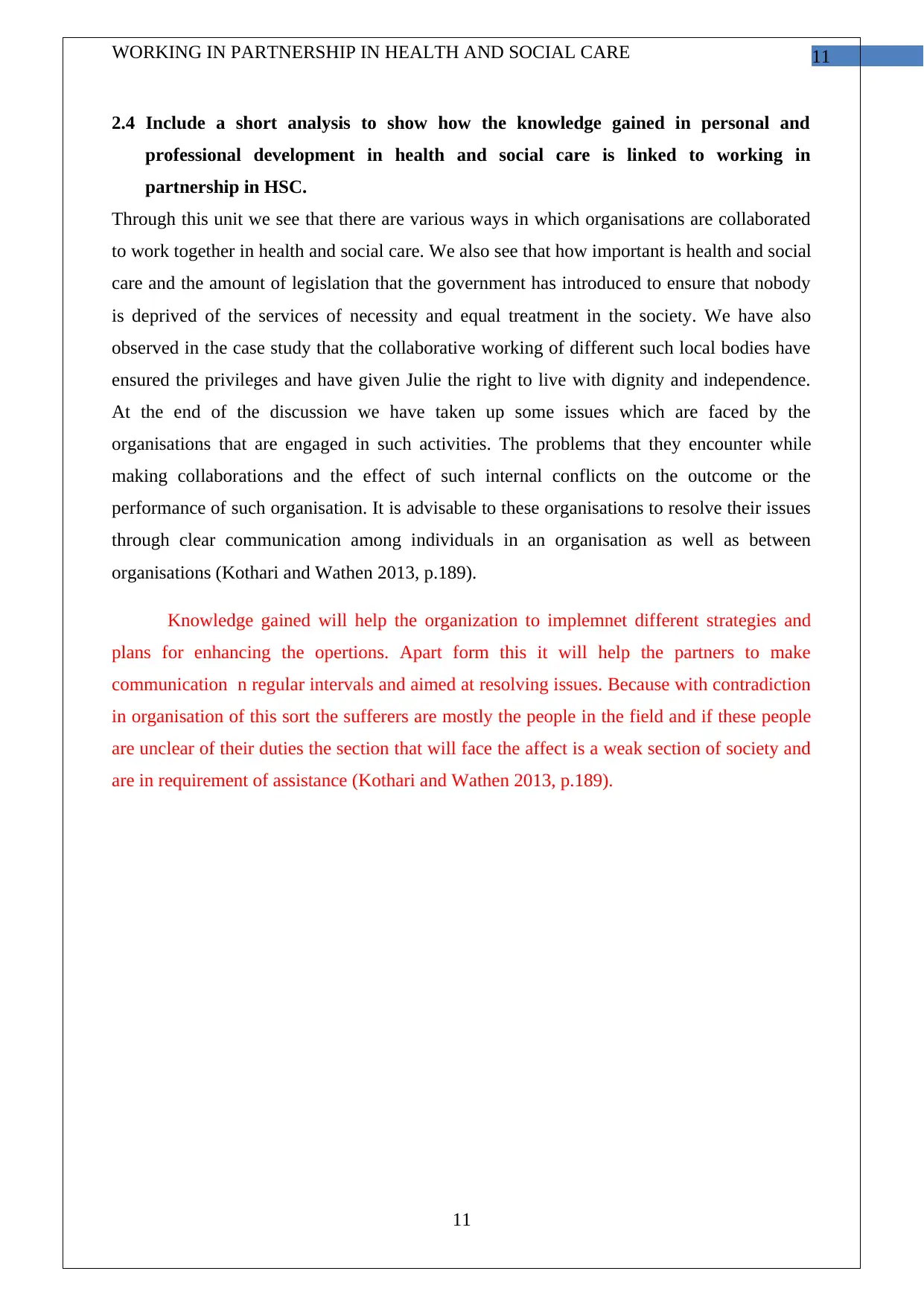
11WORKING IN PARTNERSHIP IN HEALTH AND SOCIAL CARE
2.4 Include a short analysis to show how the knowledge gained in personal and
professional development in health and social care is linked to working in
partnership in HSC.
Through this unit we see that there are various ways in which organisations are collaborated
to work together in health and social care. We also see that how important is health and social
care and the amount of legislation that the government has introduced to ensure that nobody
is deprived of the services of necessity and equal treatment in the society. We have also
observed in the case study that the collaborative working of different such local bodies have
ensured the privileges and have given Julie the right to live with dignity and independence.
At the end of the discussion we have taken up some issues which are faced by the
organisations that are engaged in such activities. The problems that they encounter while
making collaborations and the effect of such internal conflicts on the outcome or the
performance of such organisation. It is advisable to these organisations to resolve their issues
through clear communication among individuals in an organisation as well as between
organisations (Kothari and Wathen 2013, p.189).
Knowledge gained will help the organization to implemnet different strategies and
plans for enhancing the opertions. Apart form this it will help the partners to make
communication n regular intervals and aimed at resolving issues. Because with contradiction
in organisation of this sort the sufferers are mostly the people in the field and if these people
are unclear of their duties the section that will face the affect is a weak section of society and
are in requirement of assistance (Kothari and Wathen 2013, p.189).
11
2.4 Include a short analysis to show how the knowledge gained in personal and
professional development in health and social care is linked to working in
partnership in HSC.
Through this unit we see that there are various ways in which organisations are collaborated
to work together in health and social care. We also see that how important is health and social
care and the amount of legislation that the government has introduced to ensure that nobody
is deprived of the services of necessity and equal treatment in the society. We have also
observed in the case study that the collaborative working of different such local bodies have
ensured the privileges and have given Julie the right to live with dignity and independence.
At the end of the discussion we have taken up some issues which are faced by the
organisations that are engaged in such activities. The problems that they encounter while
making collaborations and the effect of such internal conflicts on the outcome or the
performance of such organisation. It is advisable to these organisations to resolve their issues
through clear communication among individuals in an organisation as well as between
organisations (Kothari and Wathen 2013, p.189).
Knowledge gained will help the organization to implemnet different strategies and
plans for enhancing the opertions. Apart form this it will help the partners to make
communication n regular intervals and aimed at resolving issues. Because with contradiction
in organisation of this sort the sufferers are mostly the people in the field and if these people
are unclear of their duties the section that will face the affect is a weak section of society and
are in requirement of assistance (Kothari and Wathen 2013, p.189).
11
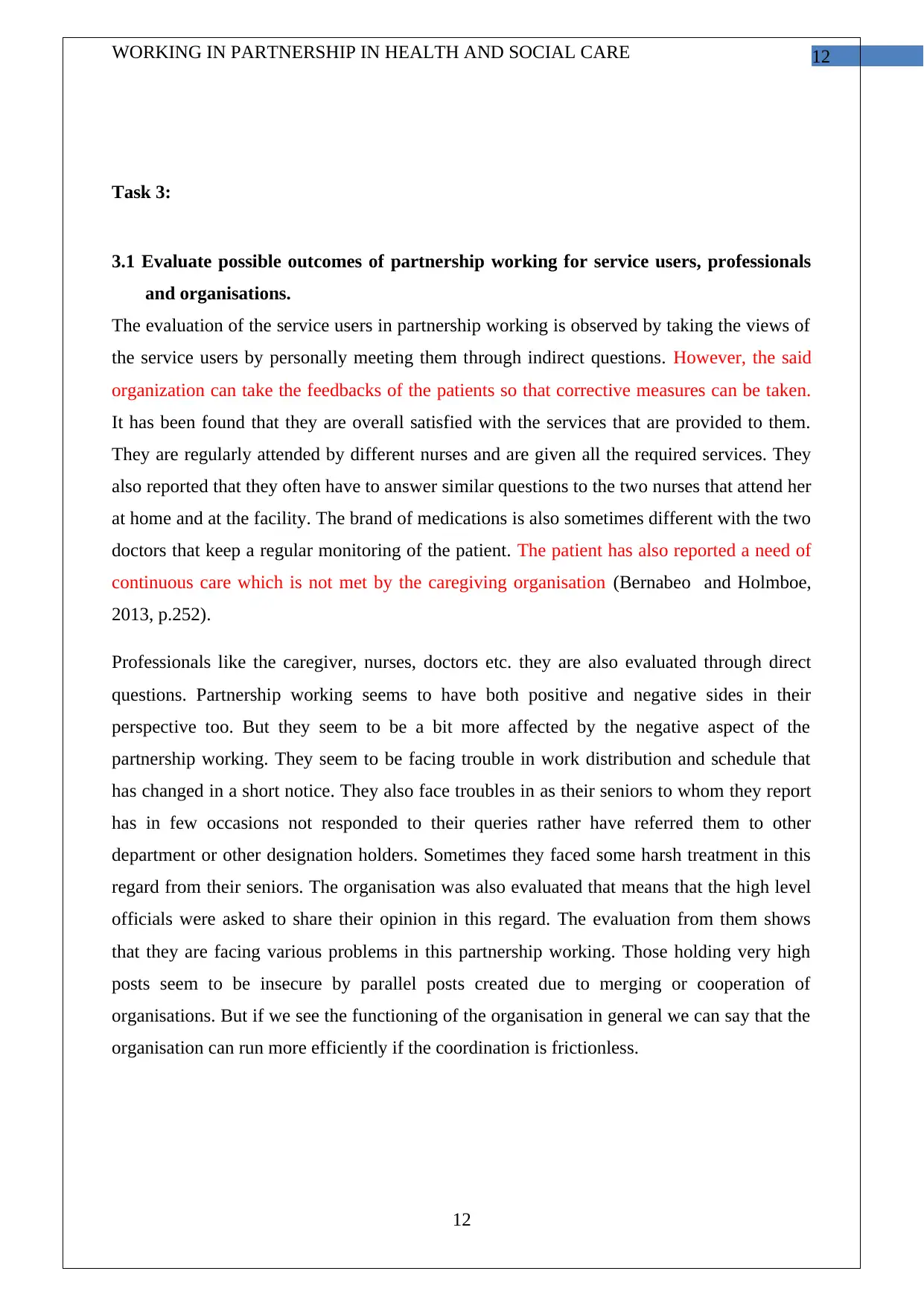
12WORKING IN PARTNERSHIP IN HEALTH AND SOCIAL CARE
Task 3:
3.1 Evaluate possible outcomes of partnership working for service users, professionals
and organisations.
The evaluation of the service users in partnership working is observed by taking the views of
the service users by personally meeting them through indirect questions. However, the said
organization can take the feedbacks of the patients so that corrective measures can be taken.
It has been found that they are overall satisfied with the services that are provided to them.
They are regularly attended by different nurses and are given all the required services. They
also reported that they often have to answer similar questions to the two nurses that attend her
at home and at the facility. The brand of medications is also sometimes different with the two
doctors that keep a regular monitoring of the patient. The patient has also reported a need of
continuous care which is not met by the caregiving organisation (Bernabeo and Holmboe,
2013, p.252).
Professionals like the caregiver, nurses, doctors etc. they are also evaluated through direct
questions. Partnership working seems to have both positive and negative sides in their
perspective too. But they seem to be a bit more affected by the negative aspect of the
partnership working. They seem to be facing trouble in work distribution and schedule that
has changed in a short notice. They also face troubles in as their seniors to whom they report
has in few occasions not responded to their queries rather have referred them to other
department or other designation holders. Sometimes they faced some harsh treatment in this
regard from their seniors. The organisation was also evaluated that means that the high level
officials were asked to share their opinion in this regard. The evaluation from them shows
that they are facing various problems in this partnership working. Those holding very high
posts seem to be insecure by parallel posts created due to merging or cooperation of
organisations. But if we see the functioning of the organisation in general we can say that the
organisation can run more efficiently if the coordination is frictionless.
12
Task 3:
3.1 Evaluate possible outcomes of partnership working for service users, professionals
and organisations.
The evaluation of the service users in partnership working is observed by taking the views of
the service users by personally meeting them through indirect questions. However, the said
organization can take the feedbacks of the patients so that corrective measures can be taken.
It has been found that they are overall satisfied with the services that are provided to them.
They are regularly attended by different nurses and are given all the required services. They
also reported that they often have to answer similar questions to the two nurses that attend her
at home and at the facility. The brand of medications is also sometimes different with the two
doctors that keep a regular monitoring of the patient. The patient has also reported a need of
continuous care which is not met by the caregiving organisation (Bernabeo and Holmboe,
2013, p.252).
Professionals like the caregiver, nurses, doctors etc. they are also evaluated through direct
questions. Partnership working seems to have both positive and negative sides in their
perspective too. But they seem to be a bit more affected by the negative aspect of the
partnership working. They seem to be facing trouble in work distribution and schedule that
has changed in a short notice. They also face troubles in as their seniors to whom they report
has in few occasions not responded to their queries rather have referred them to other
department or other designation holders. Sometimes they faced some harsh treatment in this
regard from their seniors. The organisation was also evaluated that means that the high level
officials were asked to share their opinion in this regard. The evaluation from them shows
that they are facing various problems in this partnership working. Those holding very high
posts seem to be insecure by parallel posts created due to merging or cooperation of
organisations. But if we see the functioning of the organisation in general we can say that the
organisation can run more efficiently if the coordination is frictionless.
12
⊘ This is a preview!⊘
Do you want full access?
Subscribe today to unlock all pages.

Trusted by 1+ million students worldwide
1 out of 17
Related Documents
Your All-in-One AI-Powered Toolkit for Academic Success.
+13062052269
info@desklib.com
Available 24*7 on WhatsApp / Email
![[object Object]](/_next/static/media/star-bottom.7253800d.svg)
Unlock your academic potential
Copyright © 2020–2025 A2Z Services. All Rights Reserved. Developed and managed by ZUCOL.





